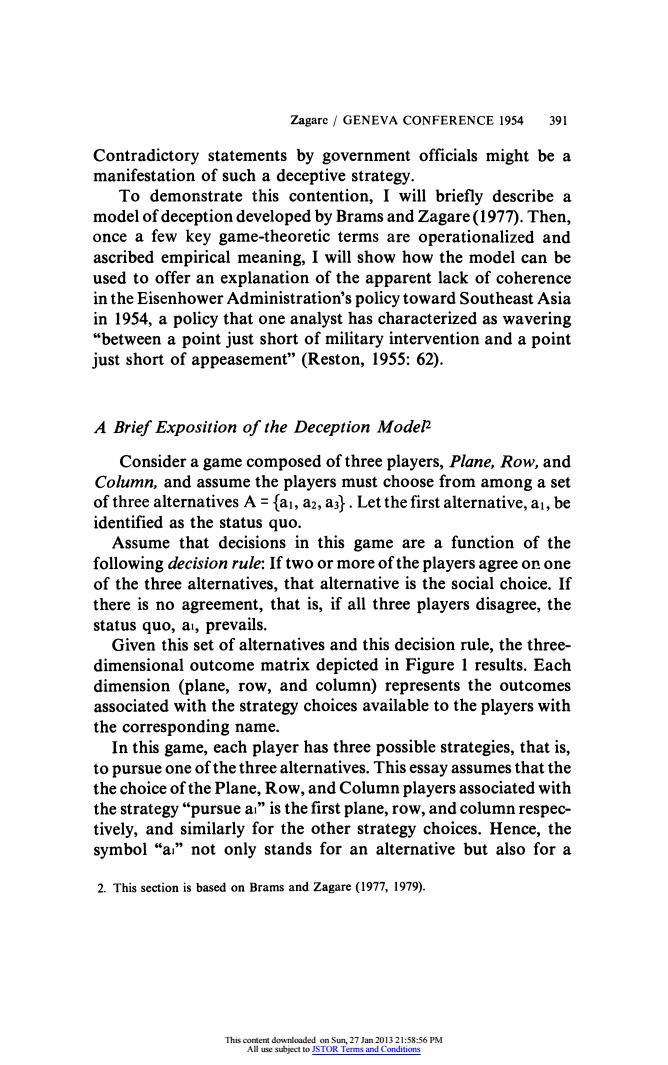正在加载图片...

Zagare GENEVA CONFERENCE 1954 391 Contradictory statements by government officials might be a manifestation of such a deceptive strategy. To demonstrate this contention,I will briefly describe a model of deception developed by Brams and Zagare(1977).Then, once a few key game-theoretic terms are operationalized and ascribed empirical meaning,I will show how the model can be used to offer an explanation of the apparent lack of coherence in the Eisenhower Administration's policy toward Southeast Asia in 1954,a policy that one analyst has characterized as wavering "between a point just short of military intervention and a point just short of appeasement"(Reston,1955:62). A Brief Exposition of the Deception Model Consider a game composed of three players,Plane,Row,and Column,and assume the players must choose from among a set of three alternatives A=fai,a2,as.Let the first alternative,a,be identified as the status quo. Assume that decisions in this game are a function of the following decision rule:If two or more of the players agree on one of the three alternatives,that alternative is the social choice.If there is no agreement,that is,if all three players disagree,the status quo,al,prevails. Given this set of alternatives and this decision rule,the three- dimensional outcome matrix depicted in Figure 1 results.Each dimension (plane,row,and column)represents the outcomes associated with the strategy choices available to the players with the corresponding name. In this game,each player has three possible strategies,that is, to pursue one of the three alternatives.This essay assumes that the the choice of the Plane,Row,and Column players associated with the strategy"pursue ai"is the first plane,row,and column respec- tively,and similarly for the other strategy choices.Hence,the symbol "a"not only stands for an alternative but also for a 2.This section is based on Brams and Zagare(1977,1979). ThPM rms and ConditionsZagare / GENEVA CONFERENCE 1954 391 Contradictory statements by government officials might be a manifestation of such a deceptive strategy. To demonstrate this contention, I will briefly describe a model of deception developed by Brams and Zagare (1977). Then, once a few key game-theoretic terms are operationalized and ascribed empirical meaning, I will show how the model can be used to offer an explanation of the apparent lack of coherence in the Eisenhower Administration's policy toward Southeast Asia in 1954, a policy that one analyst has characterized as wavering "between a point just short of military intervention and a point just short of appeasement" (Reston, 1955: 62). A Brief Exposition of the Deception Model2 Consider a game composed of three players, Plane, Row, and Column, and assume the players must choose from among a set of three alternatives A = {a,, a2, a3}. Let the first alternative, ai, be identified as the status quo. Assume that decisions in this game are a function of the following decision rule: If two or more of the players agree on one of the three alternatives, that alternative is the social choice. If there is no agreement, that is, if all three players disagree, the status quo, ai, prevails. Given this set of alternatives and this decision rule, the threedimensional outcome matrix depicted in Figure I results. Each dimension (plane, row, and column) represents the outcomes associated with the strategy choices available to the players with the corresponding name. In this game, each player has three possible strategies, that is, to pursue one of the three alternatives. This essay assumes that the the choice of the Plane, Row, and Column players associated with the strategy "pursue ai" is the first plane, row, and column respectively, and similarly for the other strategy choices. Hence, the symbol "as" not only stands for an alternative but also for a 2. This section is based on Brams and Zagare (1977, 1979). This content downloaded on Sun, 27 Jan 2013 21:58:56 PM All use subject to JSTOR Terms and Conditions